Our Sun transits in the Galactic Center in the third week of December from the 17th to the 22nd. Known in the Vedic tradition as Vishnunabhi, the Navel of Lord Vishnu, the Galactic Center spans from about two to seven degrees of sidereal Sagittarius. This center is the source of cosmic light and creative power for our whole Milky Way Galaxy including the solar system in which we live. Our Sun is recharged and rejuvenated through an “energetic upgrade” when it transits here, just in time for the new year ahead.
 The solstice occurred on December 21, 2019 at 11:19 PM EST (December 22, 2019 at 4:19 AM UTC). This was the winter solstice in the northern hemisphere, and summer solstice in the southern. The winter solstice is the beginning of the solar new year — the Sun’s waxing half of the year — known as uttarayana in Vedic astrology. It extends from the winter to the summer solstice and is the time when the gods have awakened from their slumber. Uttarayana is considered the most fruitful half of the year for establishing anything of material or worldly consequence. In the southern hemisphere at the December 21 summer solstice, it is the beginning of dakshinayana — the Sun’s waning half of the year — the half of the year for purification and healing, when the gods are in their sleep cycle. These cycles are reversed between the two hemispheres.
The solstice occurred on December 21, 2019 at 11:19 PM EST (December 22, 2019 at 4:19 AM UTC). This was the winter solstice in the northern hemisphere, and summer solstice in the southern. The winter solstice is the beginning of the solar new year — the Sun’s waxing half of the year — known as uttarayana in Vedic astrology. It extends from the winter to the summer solstice and is the time when the gods have awakened from their slumber. Uttarayana is considered the most fruitful half of the year for establishing anything of material or worldly consequence. In the southern hemisphere at the December 21 summer solstice, it is the beginning of dakshinayana — the Sun’s waning half of the year — the half of the year for purification and healing, when the gods are in their sleep cycle. These cycles are reversed between the two hemispheres.
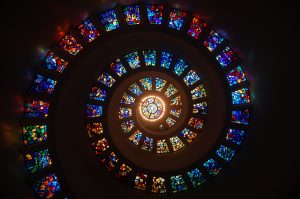 The three days before and after the solstice mark an extremely subtle period for our planet and all life, so it’s important to slow down and be more introspective now. Spiritual gateways are opening and energies are shifting, and this can be a magnificent experience for those who are tuned inward, but functioning in the everyday world may require some added awareness. According to classical Muhurta (Indian elective astrology), nothing of long-term importance should be initiated in the three days before and after the solstice. This is because the Sun in the solstice window is in a “sensitive” transitional phase. The Sun is the soul of the world and the vitality of everything in life, and it needs to be in a stable transit when we set anything new into motion, if we want that matter to have positive lasting results.
The three days before and after the solstice mark an extremely subtle period for our planet and all life, so it’s important to slow down and be more introspective now. Spiritual gateways are opening and energies are shifting, and this can be a magnificent experience for those who are tuned inward, but functioning in the everyday world may require some added awareness. According to classical Muhurta (Indian elective astrology), nothing of long-term importance should be initiated in the three days before and after the solstice. This is because the Sun in the solstice window is in a “sensitive” transitional phase. The Sun is the soul of the world and the vitality of everything in life, and it needs to be in a stable transit when we set anything new into motion, if we want that matter to have positive lasting results.
Astrologers employ a wide variety of horoscopes to forecast upcoming world affairs and events, which encompasses the branch of astrology known as “Mundane Astrology.” One horoscope I use is the one for the winter solstice. According to my friend, Vedic astrologer Souvik Dutta, there is a basis for this chart in Vedic astrology, specifically in the Nārada-saṁhitā (Jyotiṣa-grantha). This chart will tell us something about the next six months of the yang/solar ascending cycle (uttarayana), which sets the stage for the entire year spanning from now until the next winter solstice.
The solstice chart can be calculated for any locale to help us see what will happen there. I like to do this for all locations on the Earth where my loved ones or I (or my clients) will be traveling, in order to be on the lookout for any potentially problematic mundane events. Here are the charts and some of my findings for the winter solstice chart for the U.S. which is set for Washington D.C.
(Note that I am a Vedic astrologer and use the sidereal zodiac and Lahiri ayanamsa):
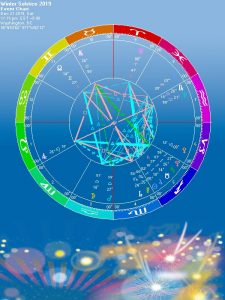
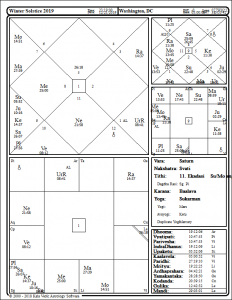 The ascendant of the solstice chart is at 26 degrees of sidereal Leo which brings an emphasis on politics; places of amusement; schools and children; fires and explosions; and the stock exchange. Leo is in the ninth house of the U.S. Kelleher birth chart, so this is overall very positive for the year ahead, since the ninth house relates to good karma and positive fortune.
The ascendant of the solstice chart is at 26 degrees of sidereal Leo which brings an emphasis on politics; places of amusement; schools and children; fires and explosions; and the stock exchange. Leo is in the ninth house of the U.S. Kelleher birth chart, so this is overall very positive for the year ahead, since the ninth house relates to good karma and positive fortune.
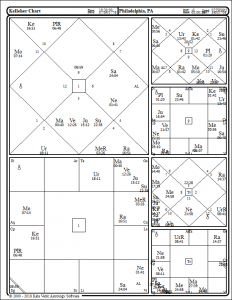
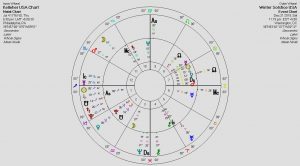 Other areas of emphasis for the ninth house include patriotism; foreign affairs such as trade agreements, and other kinds of treaties with foreign nations; educated classes, science, and higher education; the Navy and shipping; religion; the judiciary, and all kinds of new discoveries. In the solstice chart, the ninth lord Jupiter and the first lord Sun trine the ninth house, which should point to 1) a very cooperative relationship between the executive and judicial branches of government, and 2) successful foreign trade negotiations such as the historic USMCA trade pact between the U.S., Canada, and Mexico, which was reached on December 10, 2019 and will soon be ratified and go into effect. Apparently, it is a much better deal than NAFTA was for workers, farmers, and all Americans.
Other areas of emphasis for the ninth house include patriotism; foreign affairs such as trade agreements, and other kinds of treaties with foreign nations; educated classes, science, and higher education; the Navy and shipping; religion; the judiciary, and all kinds of new discoveries. In the solstice chart, the ninth lord Jupiter and the first lord Sun trine the ninth house, which should point to 1) a very cooperative relationship between the executive and judicial branches of government, and 2) successful foreign trade negotiations such as the historic USMCA trade pact between the U.S., Canada, and Mexico, which was reached on December 10, 2019 and will soon be ratified and go into effect. Apparently, it is a much better deal than NAFTA was for workers, farmers, and all Americans.
However, I wouldn’t say that trade negotiations and international affairs will be completely harmonious, because Mars, the ruler of the ninth house of trade negotiations and global affairs, is in a 6/8 (shasta-ashtakam, also known as a quincunx/inconjunct) with the MC which symbolizes the President and the executive branch of the government. This aspect can indicate some strained and stalled discussions and dealings between the U.S. and various other countries within the international community.
The nakshatra rising (lagna or ascendant) is Purva Phalguni, which according to Practical Mundane Astrology by J.C. Luthra represents “loyalty to the ruler,” as well as transportation matters and the entertainment industry. My sense of this rising nakshatra is partly positive in that Purva Phalguni, or “Pubba” as it is often called, is very creative and fosters new growth. However, Pubba also has a shadow side, especially when it falls in Scorpio navamsa as in this case, where it can point to melodramatic human interactions and some contentiousness within the collective reality.
The Sun is of course the most important player in a solstice chart, and even more so here as the Sun rules the Leo ascendant. The Sun is extremely well-placed in Sagittarius in the auspicious fifth house conjoined Jupiter, ruler of the fifth house, forming a combination known as Trikona Raja Yoga which reflects some good karma, wealth, and heightened success. The Sun and Jupiter are also conjoined Ketu which magnifies their positive effects. Saturn and Pluto are also in the fifth house in Sagittarius, but not within an effective orb of the Sun and Jupiter.
This conjunction with Jupiter should bode well for our leadership in 2020, as the President is symbolized by the Sun as the elected leader of the nation. The fact that the President is currently in a political impeachment inquiry and process is reflected by this conjunction with Ketu, which will eclipse the Sun and the Moon on December 26 right after midnight. (Please refer to my previous Impeachment and Solar Eclipse articles for more about this).
The Moon naturally represents the common people of the nation as well as the collective unconscious. Here the Moon is weak in the eleventh (ekadashi) tithi of the waning third-quarter Moon, which reflects a “crisis in consciousness.” The Moon is further distressed as it rules the twelfth dusthana house (a potentially difficult house of our undoing), which can point to foreign matters, as well as themes of alienation, misery, misfortune, mental and physical illness, negative thinking, fear, loss, waste, illusion, confusion, and criminality. This all points to what I believe is a significant problem in America now, which is the need for healing within an overwrought mass mind that is inherently pessimistic, paranoid, polarized, and discontent. This is a reflection of the nation’s karma during the afflicted 18-year Rahu mahadasha which began in 2015.
The Moon conjoins Mars in sidereal Libra in the third house forming Chandra Mangala Yoga, which signifies a highly impassioned and potentially disturbing dynamic related to third house matters. And guess what the third house in a mundane horoscope represents? The mental attitude of the people (public opinion)! The third house also symbolizes respiratory diseases or other kinds of illness; communication, published writings; public relations; and all kinds of media; traffic and transportation matters including accidents and disturbances in transportation and travel; treaties with neighboring countries; and emigration (people moving out of the country).
The Moon squares Venus in the sixth house, indicating the chronic suffering and dissatisfaction that exists among much of the populous. Mars, planet of violence, accident, and strife, occupies the fiery and fixated Vishakha nakshatra in the third house, and this along with its conjunction to the Moon (the public), which occupies the righteous and hot-tempered Swati nakshatra, points to ever more aggression being expressed in social media, and ever-more heated and biased political propaganda being broadcast 24/7 by corporate media.
All this said, the greatest spiritual teachers in history have explained time and again that each one of us is responsible for our individual and collective consciousness. I believe that by improving our individual attitudes, we can each begin to create positive change for not only ourselves but also for the mass mind and culture. In order to do this, one needs to be emotionally and psychologically healthy (including doing “shadow work” to withdraw psychological projection); and to have awareness and avoidance of all the deceptive media programming that’s going on around the clock.
Mars with the Moon in the third house indicates some potential for significant public danger or concern in regard to a health crisis or accidents (as in fires and explosions), and also related to foreign travel or any kind of transportation (cars, planes, ships, or railways). This is further suggested by the aspect from Rahu in Ardra (arduous) nakshatra, which can suggest an attack or threat by a foreign influence. The Mars-Moon conjunction in the third house also points to the appalling ongoing trend of internal violent attacks by and on our own citizens.
Mercury is in Scorpio in its own Jyestha nakshatra in the fourth house in a Papa Kartari Yoga, in which it is hemmed from the adjoining houses by Mars and Saturn, which could possibly indicate some tension in matters related to the auto industry, real estate, mining and minerals, or educational institutions.
Venus rules the third house (Libra) and the tenth house (Taurus), and occupies the sixth house in Capricorn. This brings an emphasis on expanding the armed services as well as some strong focus on national health care and health care management. It indicates some progress in employment numbers that we are now seeing, as well as some support for the working classes.
However, Venus is squared by the Moon in the third house, which suggests the unabated national malaise within some of the populace along with the nation’s growing drug problem and also ballooning national debt (the largest in the world). In addition, this Moon-Venus square, along with the square from Venus to Uranus in Aries in the ninth house, repeats the strong possibility of a health crisis or natural or man-made disaster or disasters, including a seismic or meteorological event, or an coordinated attack on the public or public transportation (planes, highways, trains, or ships).
Rahu is in Gemini in Ardra nakshatra in the eleventh house, generally a very good yoga for the economy, but also one that is not so great for the Congress in Washington. Rahu here seems to reveal more of the same difficulties we have seen in the affairs of the country, much due to the ineffective partisan politics in Congress that have existed a long time and continue to this day as a reflection of the polarized national psyche. This situation is also suggested by the fact that the ruler of the eleventh house of Congress, Mercury, is in Papa Kartari Yoga where it is under pressure by the negative power as seen by malefics Mars and Saturn hemming it in from the adjoining houses.
Neptune is conjoined the descendant (asta lagna) in the seventh house, which indicates “treachery and double dealing on the part of foreign powers…it warns a nation to be on guard against plots, schemes, and secret attacks…(Mundane Astrology, Manik Chand Jain, p. 90). Neptune also symbolizes infectious diseases (whether by natural transmission of biological warfare) and also represents related hidden agendas coming from foreign enemies.
I will be writing more mundane forecasts for 2020 in the weeks and months to come, and will be looking at a variety of charts including the New Year’s major transits and eclipses (especially those involving Jupiter-Saturn-Pluto); the U.S. dashas; and the Vedic New Year chart set for March 24, 2020. Until then, happy holy days and a blessed, healthy, and prosperous 2020 to all my readers. Thank you for being here!

